The Aquatic Songbird: American Dippers
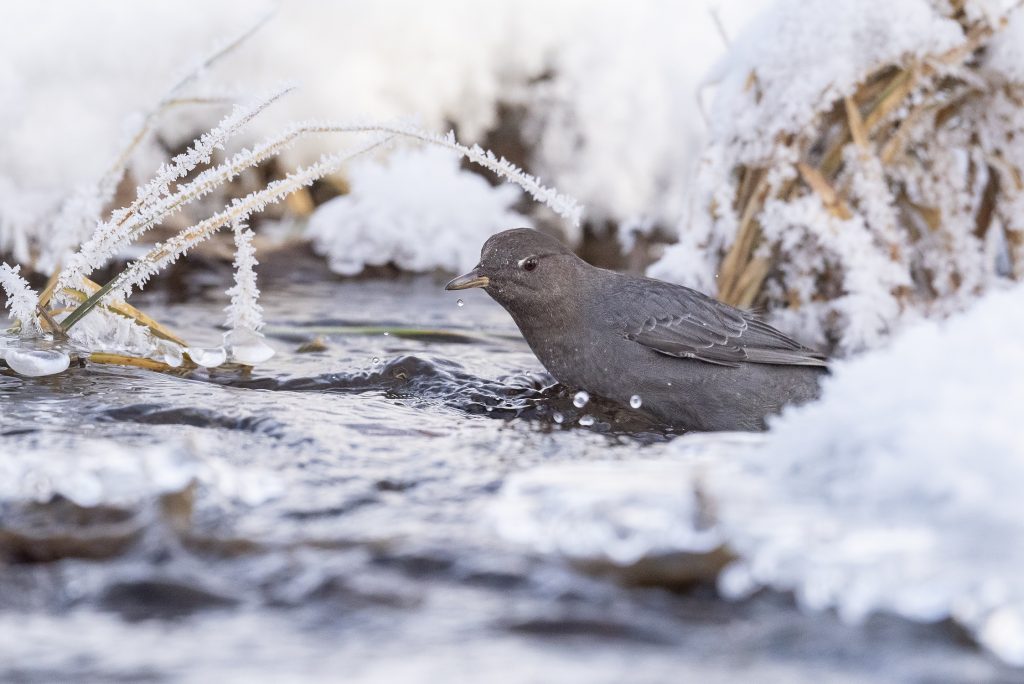
BY MARK BRADLEY

Dippers are never far from fast water. Mark Bradley
I had been a flatlander my entire life when I moved to Jasper in 2005. Enamoured of my new mountain home, I was taking a mid-winter hike and enjoying the view. I could see my breath and hear the snow crunch beneath my boots as I walked along the edge of a swiftly flowing stream. That’s when I heard a long, complex, and melodious song. I thought, “What kind of crazy bird is singing cheerfully at –20℃?” Then I caught a glimpse of a little grey bird standing on a rock — my first sighting of an American dipper! I watched with fascination as this tiny songbird jumped in and out of the water with no regard to the frigid temperatures.
Although American dippers have no distinctive field marks, they are unlikely to be confused with other songbirds because of their fondness for aquatic foraging along flowing streams. American dippers are plump little birds, 18–21 cm, that weigh about 50 grams (roughly the weight of a golf ball). Both sexes have a slate-grey body with a brownish-grey head, an upturned tail, and flashing white eyelids. The juveniles are a lighter grey with a whitish throat and some belly barring. The bill varies from dark grey to yellow depending on age and the time of year.
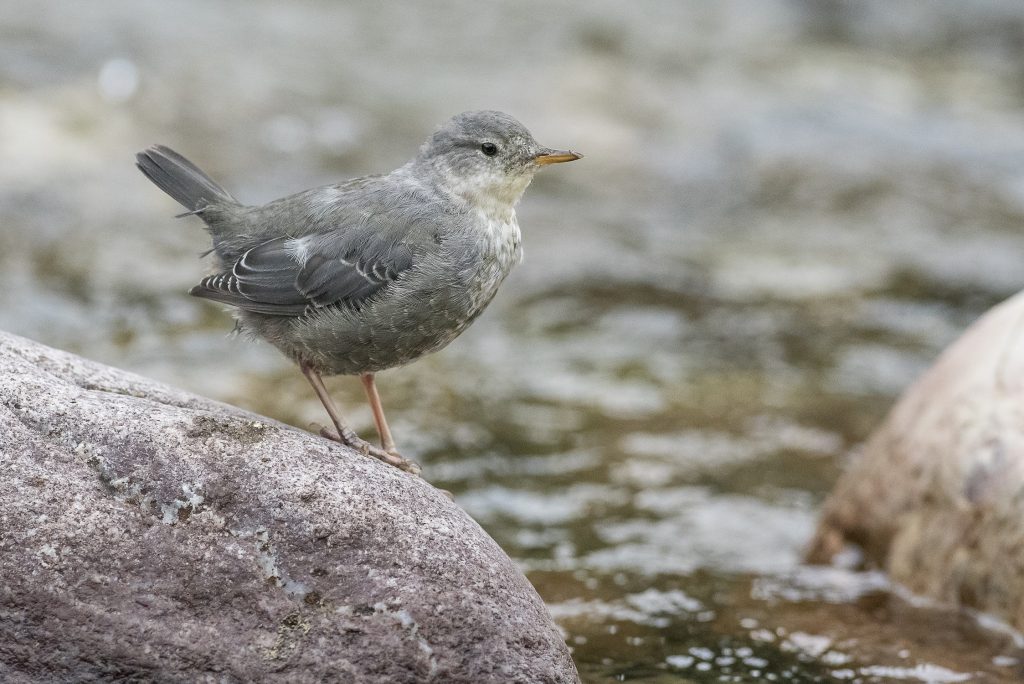
Juveniles are a paler grey, with a whitish throat and some patterning on the belly. Mark Bradley
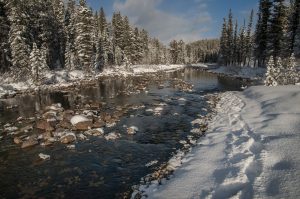
Typical dipper habitat: a shallow stream with a rock and gravel substrate. Mark Bradley
Since American dippers are only found near swiftly flowing mountain streams, their distribution just barely makes it into Alberta. Their range extends across the western mountain ranges from Alaska down to Panama. Four additional dipper species exist, distributed across South America, Asia, Africa, and Europe. Old World flycatchers are their closest relatives. Unlike many passerines (perching birds in the order Passeriformes), dippers do not migrate to warmer climes for the winter, though they may descend short distances to maintain access to open water.
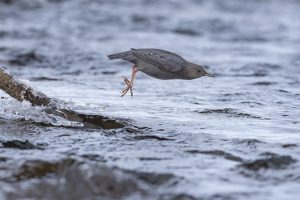
Dippers will jump and dive from low perches. Mark Bradley
The American dipper’s main food source is aquatic invertebrates. Caddisfly larvae seem to be a particular favourite where I watch them, but they will take a wide variety of insects, and will even tackle small fish when they can get them. Dippers have a variety of foraging techniques, but all involve catching prey underwater. They will often stand on a low rock in a stream, scanning for movement, then jump in the air and dive completely underwater, emerging with an insect in their beak. They will also stand in shallow running water with their heads underwater, snapping up insects as they come within range. Flipping rocks also seems to be a favourite tactic. Most impressively, they can swim to the bottom of the stream using their wings and walk along the streambed in search of prey.
Dippers are aggressively territorial. Stretches of suitable habitat, particularly swiftly moving shallow water with a gravelly or rocky substrate, are jealously guarded. Territorial behaviours include calling, chasing, and posing on rocks with beak pointed to the sky and wings shaking. Territoriality is kicked up a notch when the breeding season starts, and considerable energy may be devoted to defending feeding habitat near a nest site.
Dippers typically nest on large rocks, cliffs, or bridges over water, making it difficult for predators to find and access their nests. The football-shaped nest is built out of moss, sticks, and bark and lined with dry grasses. Both males and females build the nest and care for the young. Clutch size is four to five eggs, incubation period is just over two weeks, and the chicks fledge within 25 days.
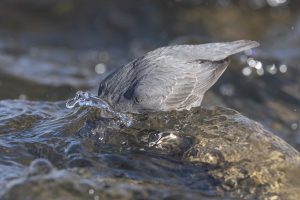
Dippers will often stand on a rock with their head underwater to search for prey. Mark Bradley
American Dippers are listed as “Least Concern” by Bird Life International and “Low Concern” by Partners in Flight, because of their large and relatively stable population. The total population is estimated to be about 160,000, though this number is imprecise because of difficult survey conditions. The bird is relatively robust to human disturbance; however, poor development decisions can lead to the pollution of mountain streams and concomitant loss of dipper habitat. Dippers have also been shown to accumulate mercury and selenium in their blood and feathers, so pollution of their streams can affect them directly and may also reduce or eliminate their local food sources. Climate change could also affect dippers as they are known to be susceptible to changes in rainfall and local hydrology.
Watching dippers is one of my favourite birding pastimes. If you want to enjoy some dipper watching for yourself, just go to the mountains and look for shallow, swiftly running streams — muddy streams will not have any dippers. Elbow Falls Provincial Recreation Area is a good place to try. You’ll probably hear their beautiful song or the incessant “chrrrr” of their territorial calls before you see them, because looking for little grey birds on grey rocks isn’t always the easiest!
References:
- BirdLife International (2023). Species factsheet: Cinclus mexicanus. birdlife.org.
- Partners in Flight Databases (2023). pif.birdconservancy.org.
- Wayland, M., J. Kneteman and R. Crosley (2006). The American dipper as a bioindicator of selenium contamination in a coal mine-affected stream in west-central Alberta, Canada. Environmental Monitoring and Assessment, 123(1), pp.285-298.
- Sullivan, S.M.P. and K.T. Vierling (2012). Exploring the influences of multiscale environmental factors on the American dipper Cinclus mexicanus. Ecography, 35(7), pp.624-636.
Mark Bradley is a recently retired Parks Canada biologist, now residing in Calgary. Over his career, Mark worked on barren-ground caribou, polar bears, peregrine falcons, whooping cranes, mountain caribou, moose, elk, Columbian ground squirrels, and grizzly bears. Mark now spends his time exploring, photographing the prairies and foothills of Alberta.
This article originally ran in Nature Alberta Magazine – Spring 2023.
